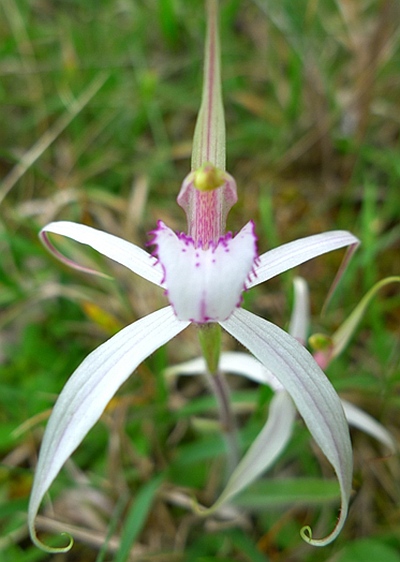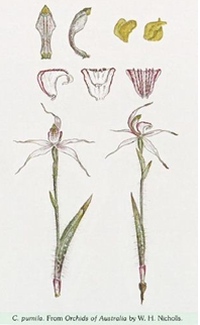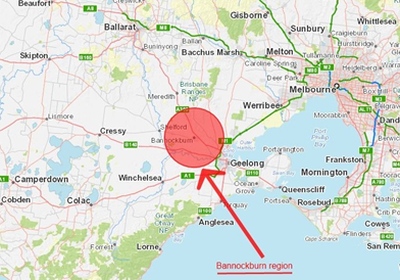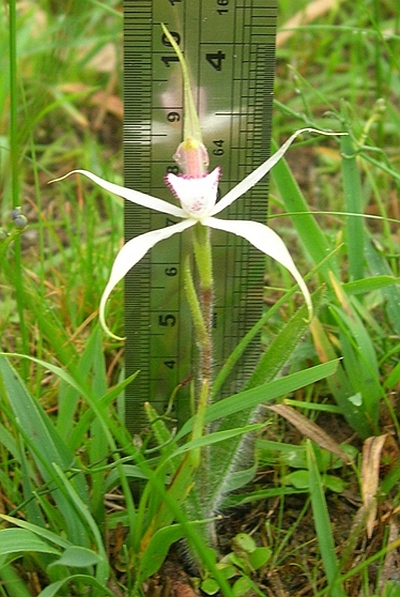Dwarf Spider Orchid
Dwarf Spider OrchidCaladenia pumila | |
|---|---|
| Kingdom: | Plantae |
| Phylum: | Magnoliophyta (Angiosperm) |
| Class: | Magnoliopsida (Monocotyledon) |
| Sub-class: | Liliidae |
| Order: | Orchidales |
| Family: | Orchidaceae |
| Status | |
| Australia: | Critically endangered |
| Victoria: | Critically endangered (FFG Threatened List 2023) |
| FFG: | Listed; Action Statement No. 260 |
| Profiles | |
| Victoria: | Flora of Victoria |
| Australia: | Atlas of Living Australia |

that is endemic to Victoria. It was thought to
be extinct until its rediscovery in 2009.
The Dwarf Spider-orchid (Caladenia pumila) was first collected by school teacher, Miss Bertha Pilloud in 1916 while she was working in Bannockburn. Miss Pilloud enthusiastically describes the orchid’s abundance at the time:
“I wish you could pay a visit to our district, and see for yourself the hillsides, where on this white spider grows, I am sure you would be delighted with the sight.”
In 1922 R.S. Rogers described the orchid, but in the following years only limited official records of the orchid were made, all collected from the Bannockburn region.
In 1932 the well-known orchidologist, William H. Nicholls, included a hand painted image (see image) of the orchid in his book Orchids of Australia. A final pressed specimen was collected in 1933, but after that date there were no further reports of the Dwarf Spider Orchid. As a result the plant was presumed extinct.

However, 76 years later in 2009, two inquisitive orchid enthusiasts came across two partially opened flowers which were unfamiliar to them. They subsequently made some enquires as to their identification, and as a result the Dwarf Spider Orchid was confirmed as being rediscovered.
Distribution

Conservation & Management
The number of Dwarf Spider-orchids in 2015 still remains precariously low, at just two plants. Land managers with help from the Department of Environment, Land, Water and Planning (DELWP), the Australasian Native Orchid Society (Victorian Group), the Royal Botanical Gardens and volunteers, are working together to bring the orchid back from the brink of extinction.
- This species is monitored at least three times per year to determine leaf emergence, flowering and pollination.
- Hand pollination has been carried out in 2010, 2012, 2013 and 2014. With as few as two flowers being present hand pollination provides an important means of securing seed from this species.
- Surveys are carried out each year to locate any additional populations.
- There is a need to control human disturbance by limiting the number of people visiting the site and their impact.
- Protective fencing was completed in 2010.
- Habitat is managed through restoration of micro-habitat which involves the careful hand removal of biomass to reduce competition from grass and weeds.
- Two small ecological fuel reduction burns are planned for 2015.
- A key aim is to establish and maintain a translocated population.
- Propagation to takes place at the Royal Botanic Gardens in Melbourne by volunteers. Flowering of a propagated plant occurred in mid-September 2017 which prompted surveys to locate this species in the wild.
The Dwarf Spider-orchid is considered Critically Endangered under the FFG Threatened List (2023) Flora and Fauna Guarantee Act 1988 - Threatened List - June 2023, Department of Energy, Environment and Climate Action (DEECA) , Victoria.
How you can help
There are a few ways you can help us. We need to know the ideal habitat of the Dwarf Spider Orchid because the old reports were very general in their description. More importantly we need to know if there are more Dwarf Spider Orchids out there than just two we currently know about so we can increase the gene pool.
Old records: Please tell us if you have any old journals that record information about any spider orchids from the Bannockburn region, such as location details or any other additional information.
Sightings: Please tell us if you recall seeing this orchid or have you heard someone talk about their orchid sightings in the Bannockburn region.
Observation: While you walk through remnant bush in the Bannockburn / Geelong area please keep an eye out for the orchid and record and report sightings.

The single white flower has fine pink markings.
Dwarf Spider-orchid identification
The Dwarf Spider Orchid is easily distinguishable from other spider orchids as it is one of the shortest.
Its single, short hairy leaf appears in May. The single white flower has fine pink markings.
The height of the single leaf is approximately 6cm. When the orchid is in flower its total height is five to 15 centimetres. Flowers appear from September to October.
Contacts
Please contact the Project Officer via the Department of Environment, Land, Water and Planning (DELWP) Customer Service Centre on 136 186 if you:
- can provide information about records and sightings of the Dwarf Spider Orchid
- have any questions about the orchid
More Information
- Flora and Fauna Guarantee Act 1988 Victoria - Action Statement No. 260 pdf
- Department of Environment - Species Profile & Threats Database

